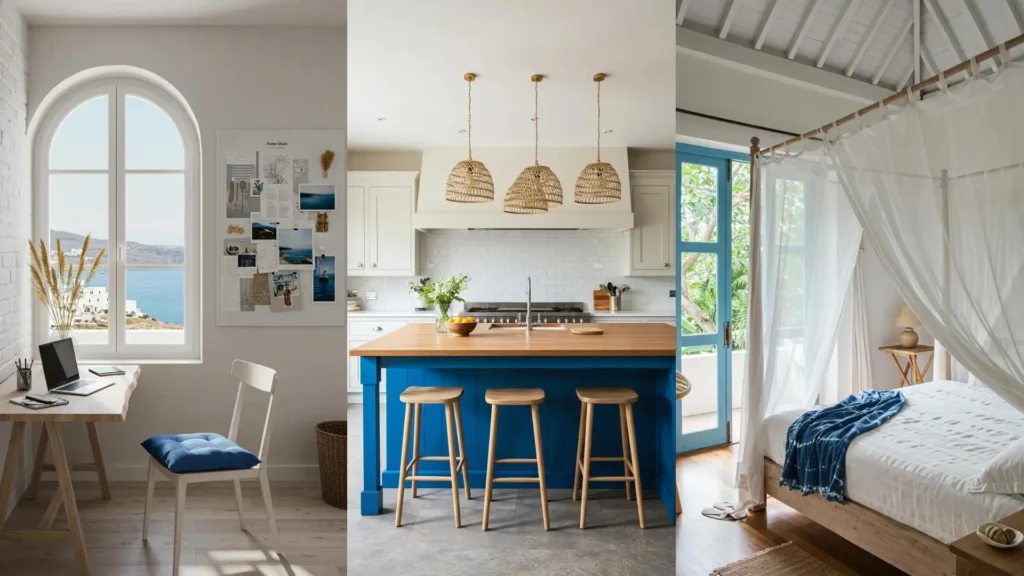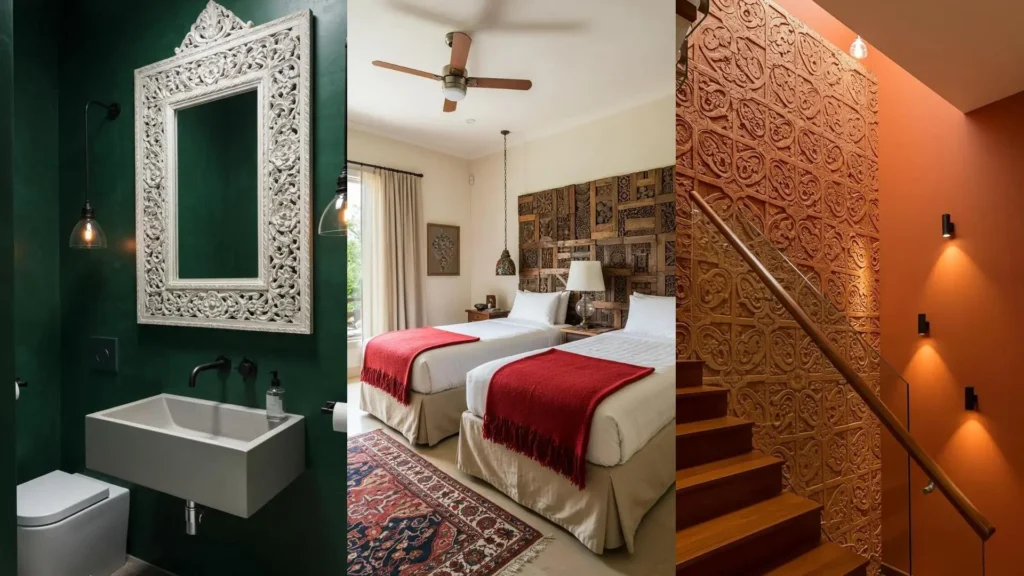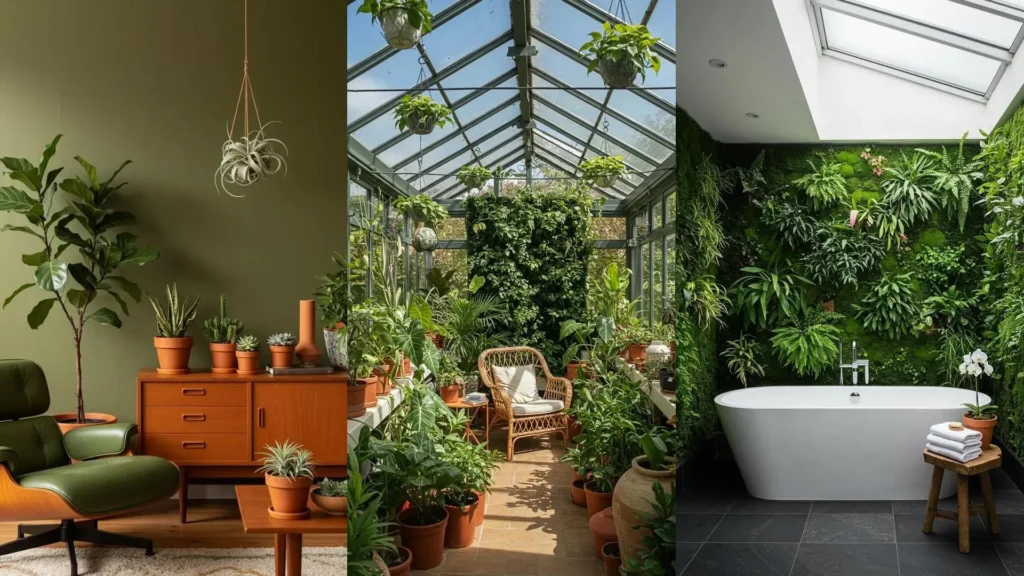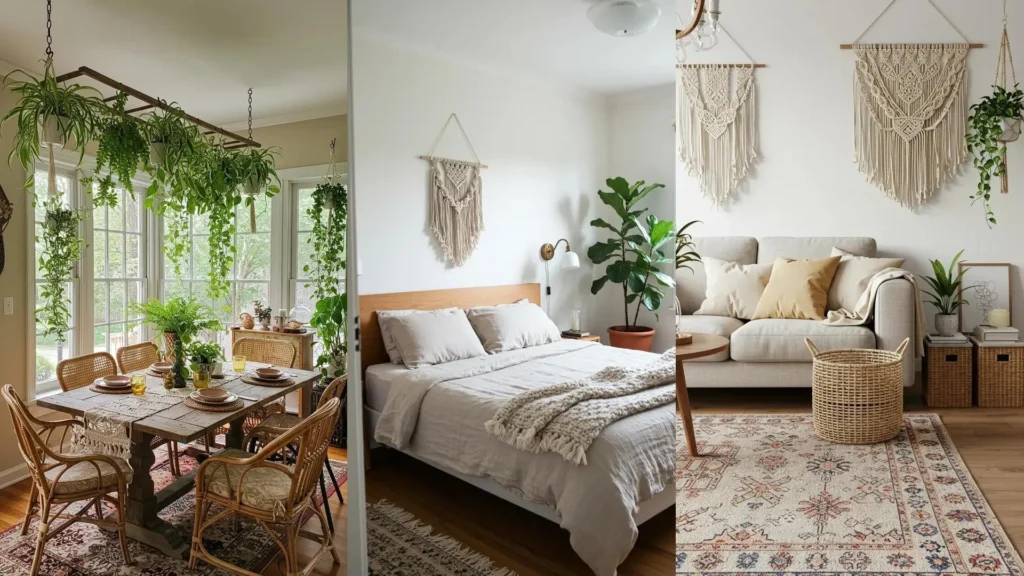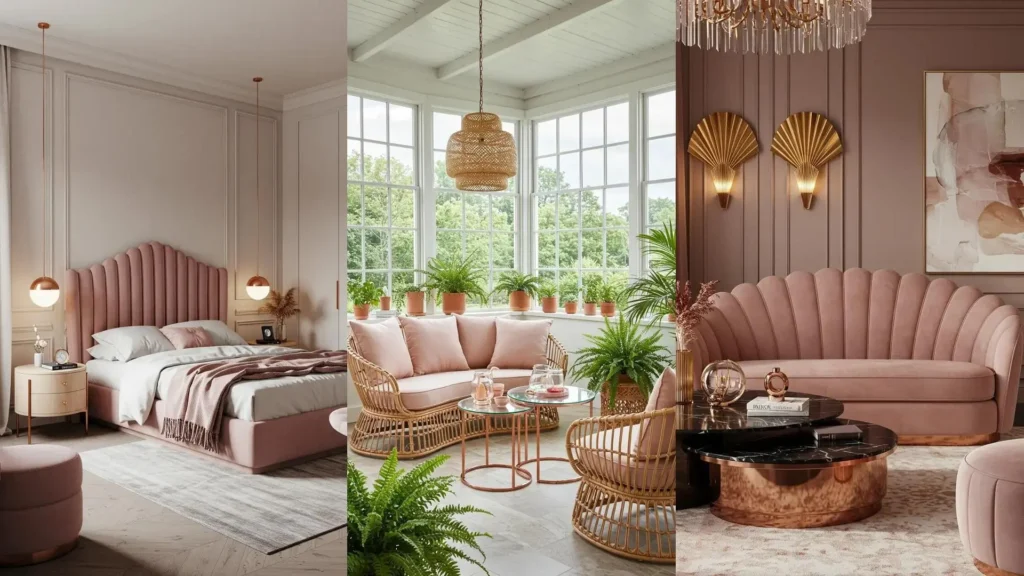The allure of Greek island interiors goes far beyond a simple blue and white color scheme.
It’s a feeling—a sense of calm that comes from sun-bleached whites, natural textures, and a deep respect for light and simplicity.
This style is about creating spaces that breathe, where architectural honesty meets rustic warmth, and every object feels chosen with intention.
You don’t need to live by the sea to capture this essence. It’s an approach to design that you can bring into your own home, corner by corner, to create a sanctuary that feels both timeless and deeply personal.
1. Ground Your Space with Earth and Sea Tones

Create a seamless, integrated look with built-in seating, which makes a room feel both spacious and cozy.
If permanent fixtures aren’t an option, mimic the effect with a low-profile sofa pushed flush against the wall.
Ground the airy, whitewashed walls with the warmth of terracotta floor tiles and a natural jute rug for texture.
Finally, incorporate large, organic elements like an olive jar to add sculptural interest and a touch of rustic history, and hang breezy drapes that filter sunlight without blocking the view.
2. Embrace Architectural Simplicity
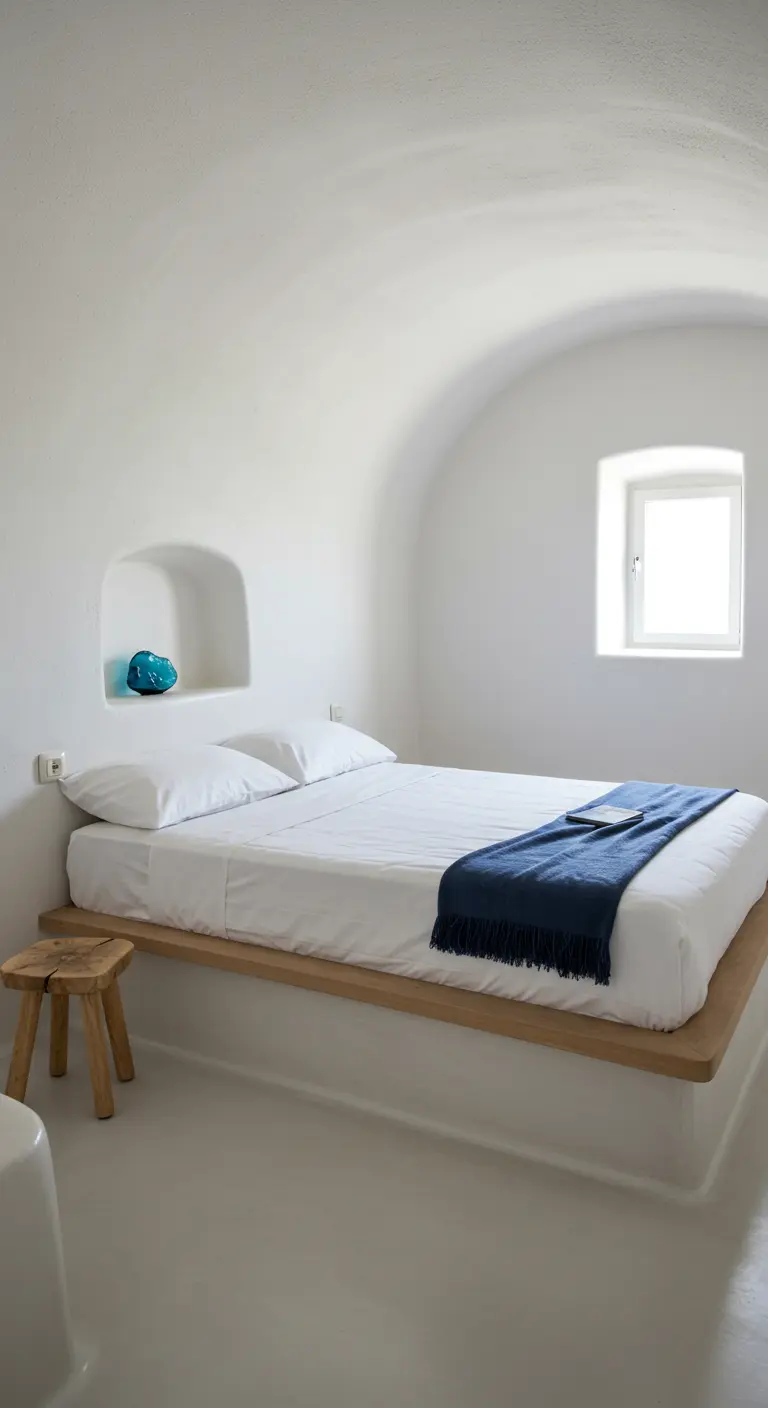
In a minimalist space, the architecture itself becomes the main feature.
A floating bed platform creates an illusion of spaciousness by revealing more of the floor.
Replace a traditional nightstand with a built-in niche to maintain clean lines and keep surfaces uncluttered.
This design choice allows a single, colorful object to have a significant impact, while a simple wooden stool adds just the right amount of organic warmth to the all-white palette.
3. Frame Your View with Color and Nature
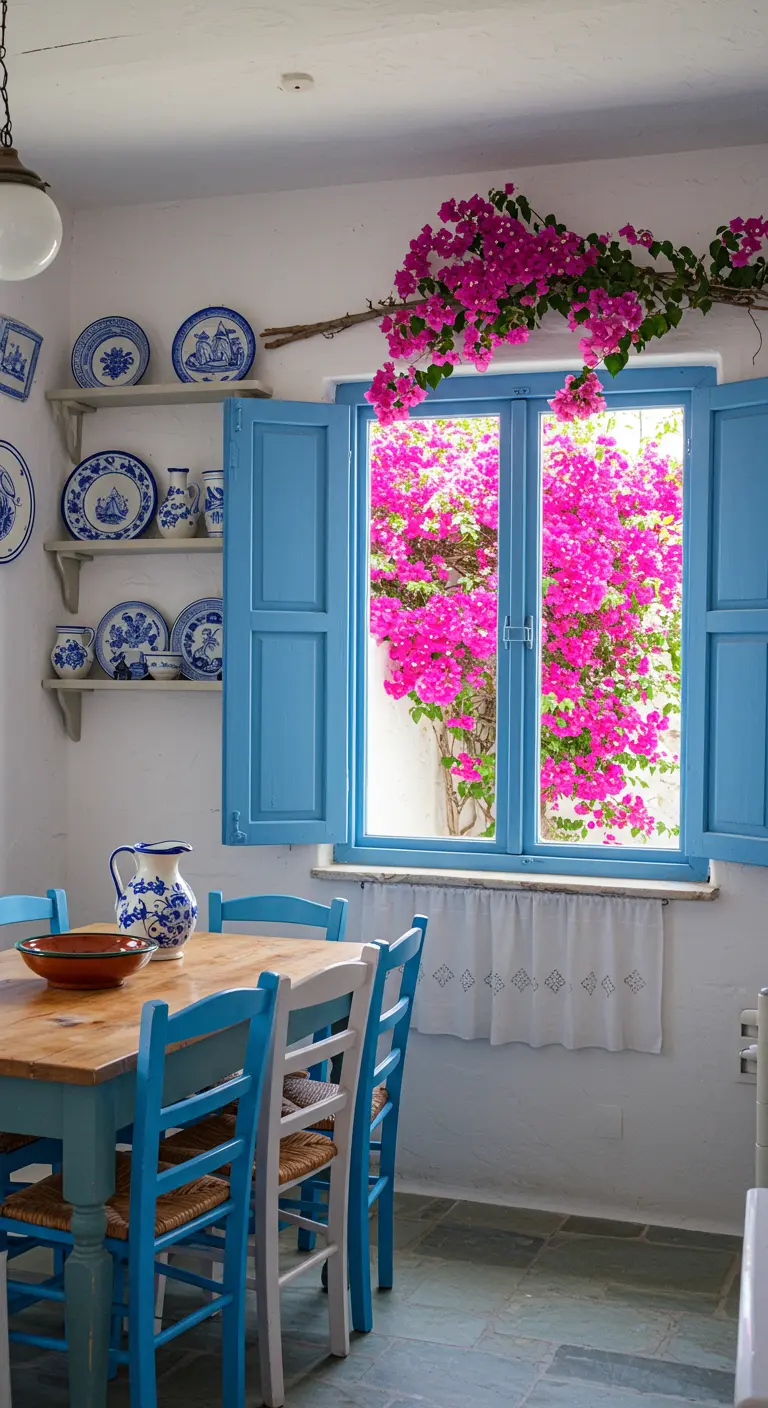
Turn your window into a deliberate focal point by painting the frame and shutters in a vibrant, welcoming blue.
This simple act draws the eye outward and celebrates the connection to the outdoors.
Strengthen that link by bringing a piece of the garden inside, like this dramatic branch of bougainvillea placed above the window.
Displaying a curated collection of blue and white ceramics on open shelves adds personality and depth, echoing the room’s primary accent color in a thoughtful way.
4. Define a Functional Zone with Statement Tile
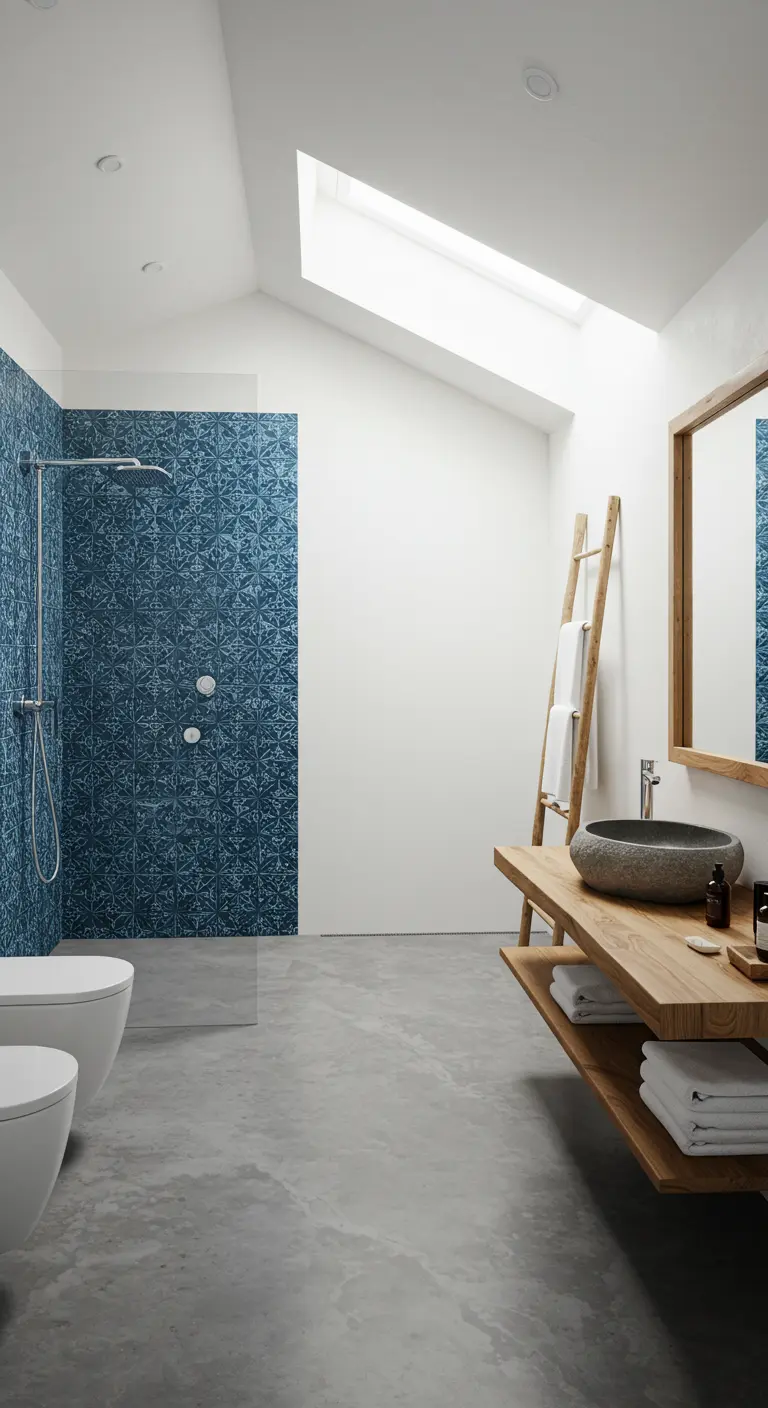
Use a bold, patterned tile to visually define a specific area, such as a walk-in shower, without adding walls.
This technique adds immense character and the feeling of a custom design feature.
To prevent the pattern from overwhelming the room, keep adjacent surfaces minimal—here, concrete floors and simple white walls create a clean backdrop.
Warm up the cool tones of the tile and concrete with natural wood elements, like a floating vanity or a ladder for towels.
5. Design an Alfresco Room with Built-in Seating
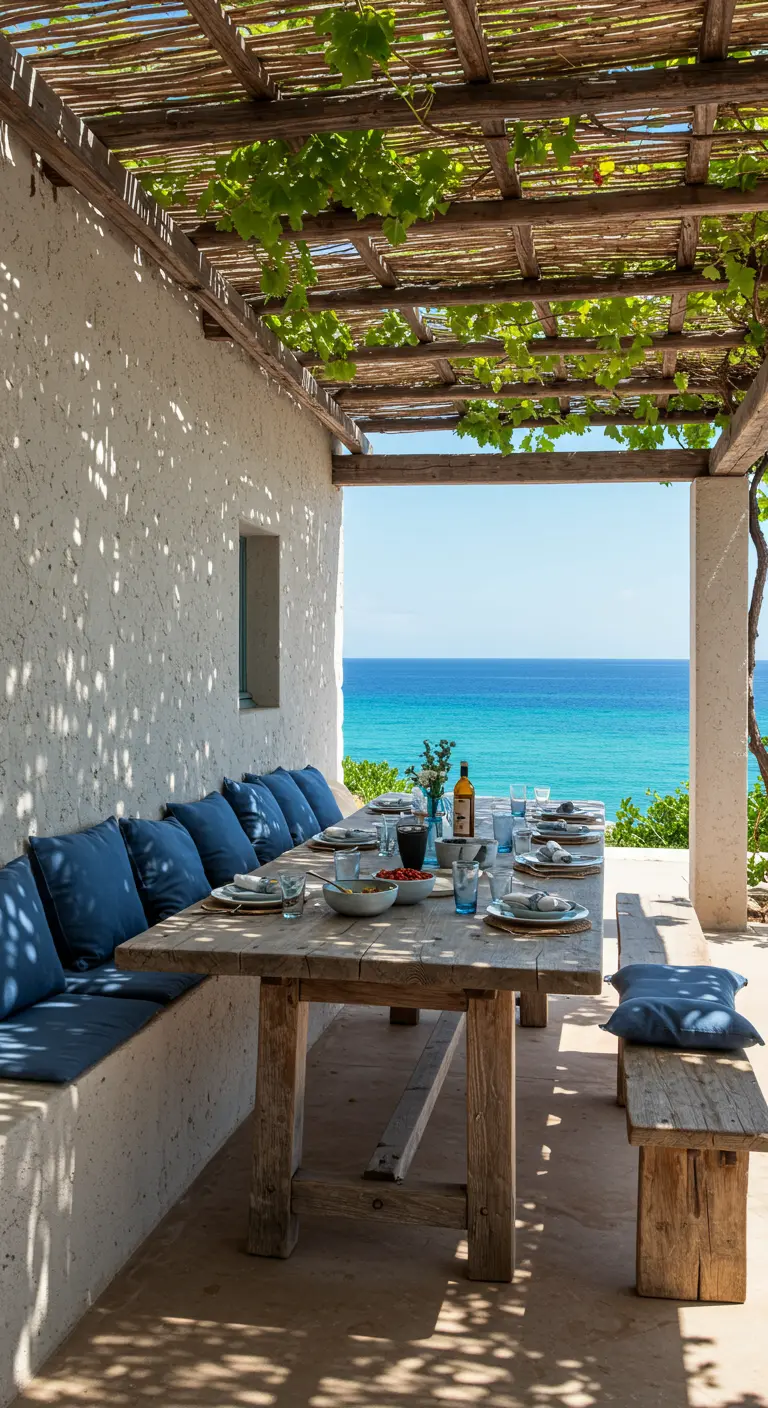
Treat your terrace like an extension of your living room by incorporating permanent, built-in seating.
A concrete or plaster bench maximizes space and feels deeply integrated with the architecture.
Contrast the smooth, cool plaster with a substantial, rustic wood table to anchor the dining area.
Deep blue cushions provide necessary comfort and a strong color statement, while a vine-covered pergola offers dappled, living shade for your alfresco table decor.
6. Announce Your Style at the Front Door
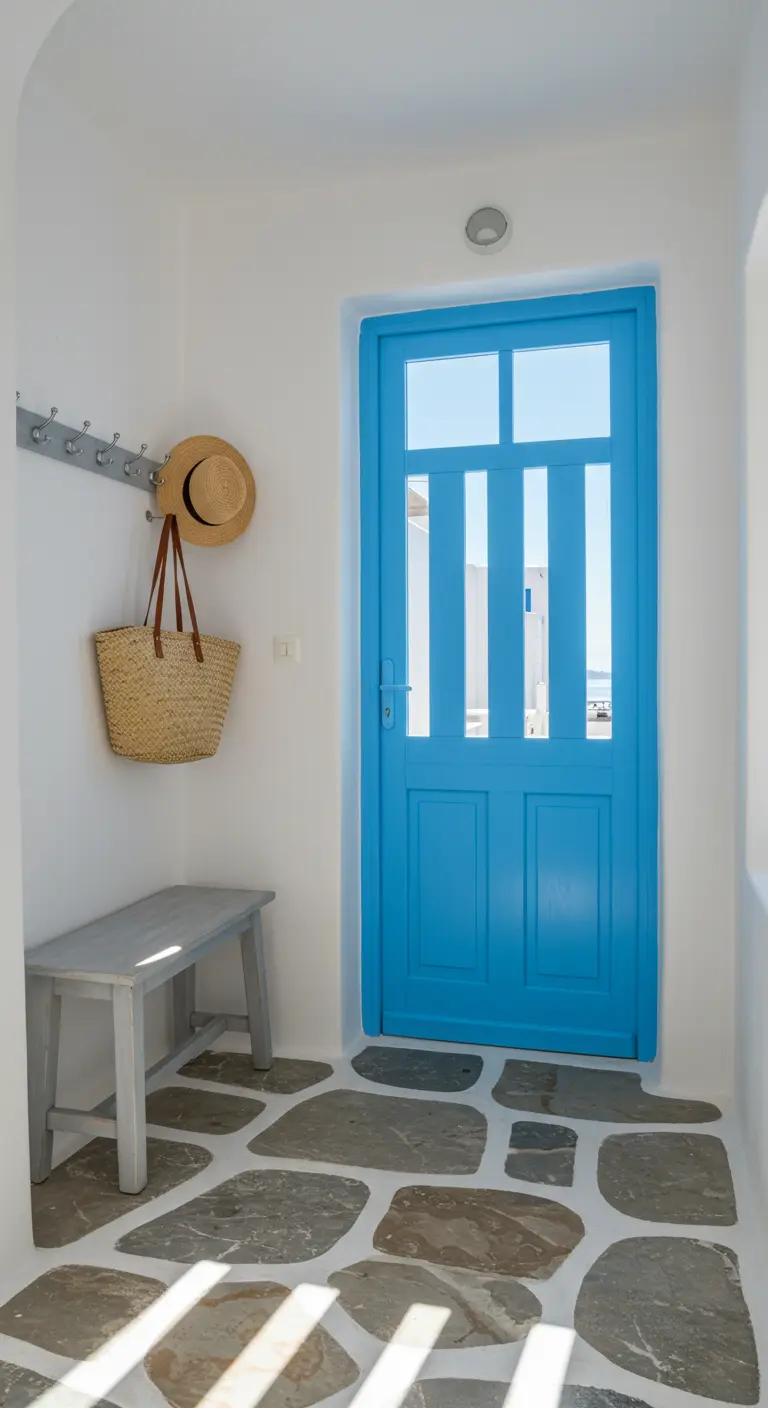
Your entryway offers the first impression of your home’s personality, so make it intentional.
A door painted in a cheerful, confident blue is a high-impact update that requires minimal effort.
Pair it with natural, organic flooring like large flagstones to create a graceful transition from the outside world.
Keep furnishings simple and functional to maintain a sense of openness; a slim bench and wall hooks are often all you need in a tiny entryway.
7. Layer Natural Textures for Depth
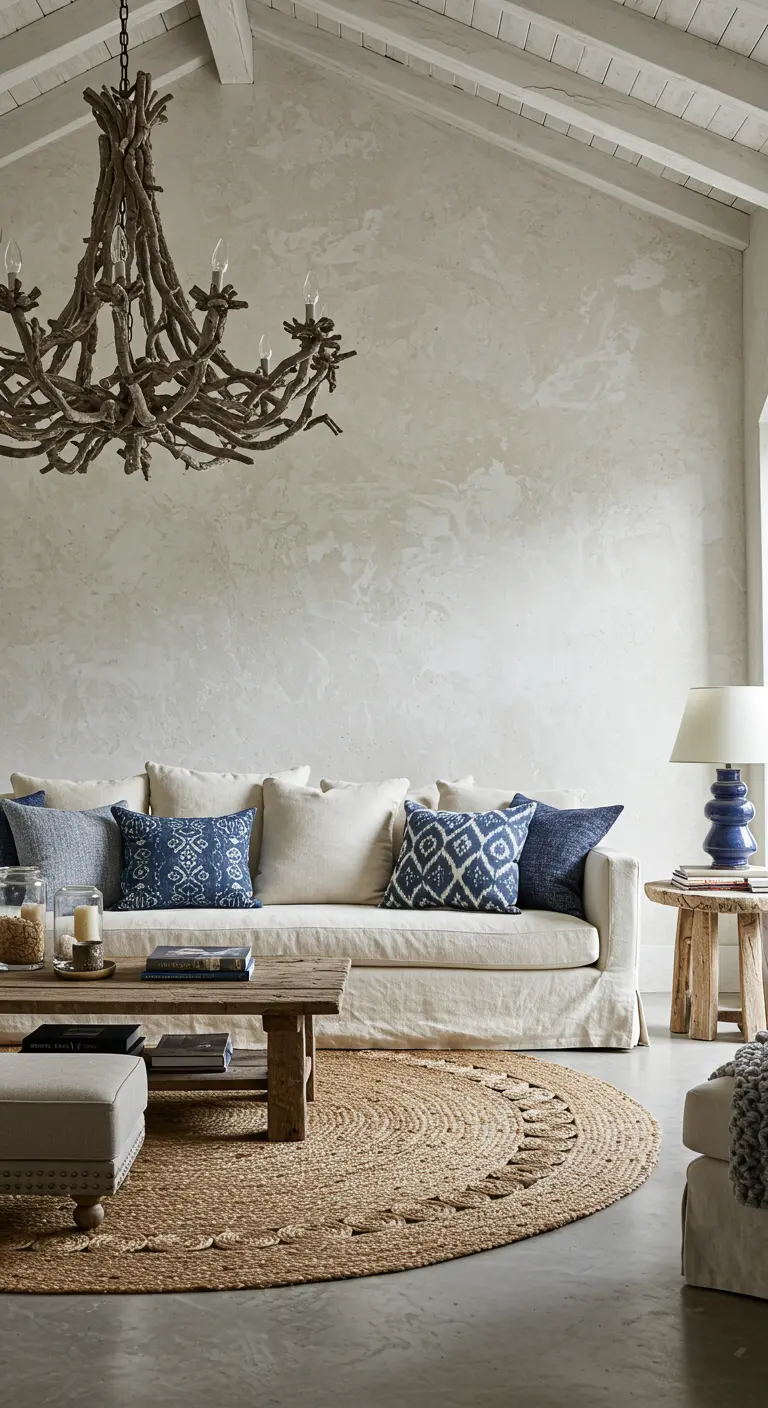
A truly sophisticated coastal look is built on a rich variety of textures, not just color.
Create compelling contrast by pairing a rough, sculptural driftwood chandelier with the softness of a linen slipcovered sofa.
Introduce a round jute rug to add another layer of natural fiber and to soften the room’s rectangular lines.
By keeping the color palette calm and neutral, you allow these beautiful, tactile materials to become the focus, achieving a look that feels both relaxed and timeless.
8. Create an Oasis with Sheer Fabric
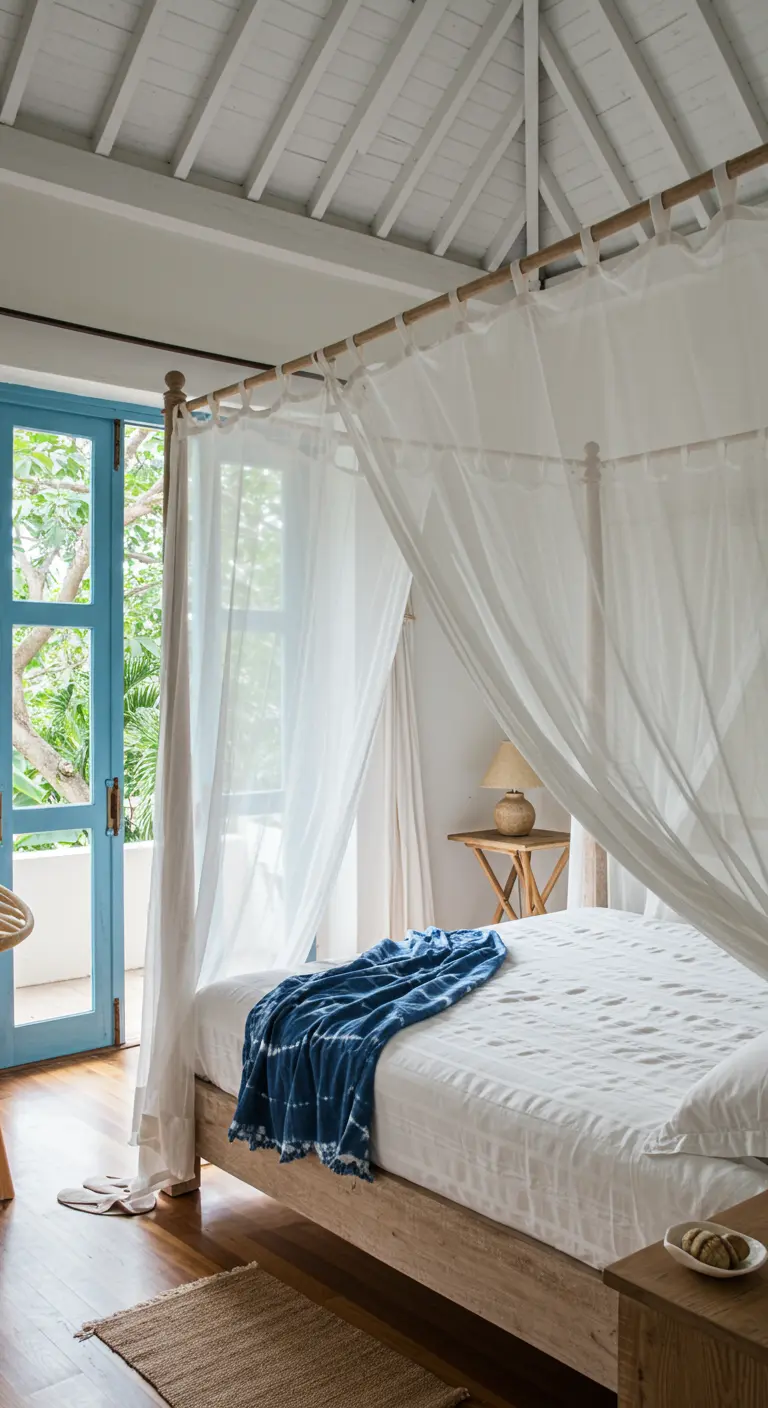
Transform a simple four-poster bed into a romantic sanctuary with sheer fabric panels.
Choose a lightweight cotton or linen voile that will catch the light and add gentle movement, creating a soft, ethereal canopy.
This approach offers a sense of privacy and enclosure without feeling heavy or blocking airflow.
To maintain the serene atmosphere, keep the rest of the room’s decor minimal, allowing the bed to remain the undisputed focal point of your dream bedroom.
9. Treat Appliances as a Color Pop
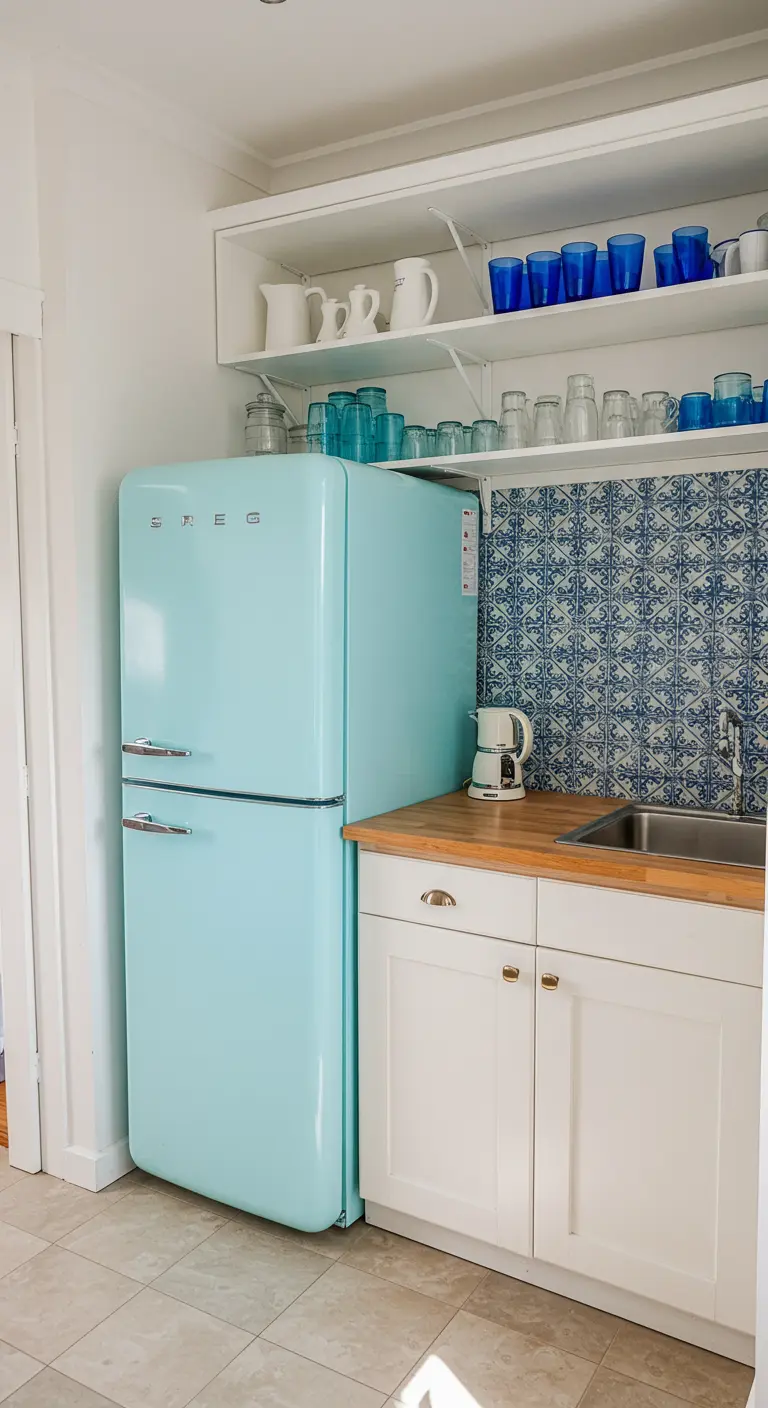
In a small kitchen, a distinctive appliance can serve as a primary design element.
A retro-style refrigerator in a soft, unexpected color provides an instant dose of personality and charm.
Echo this accent color in a patterned tile backsplash to create a cohesive, layered look.
This strategy is particularly effective in rental kitchens or compact spaces, where it adds significant character without requiring a major renovation.
10. Carve Out a Restful Reading Nook
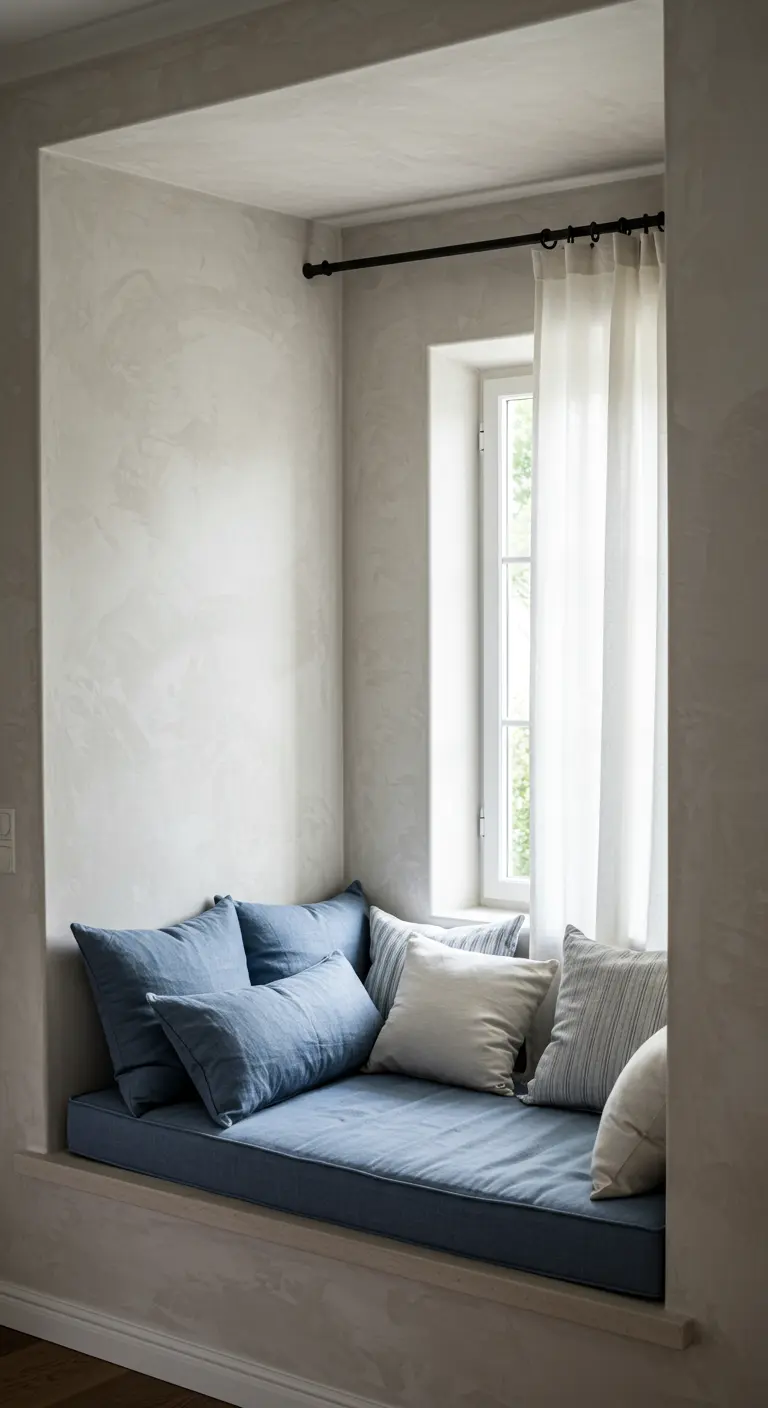
Transform an underutilized alcove or corner into a destination with a custom-fit bench.
The key to making it truly inviting is generous cushioning—start with a thick base cushion and layer on an abundance of pillows in varied sizes and textures.
Using a mix of solids and subtle stripes within the same color family adds depth without creating visual clutter.
These cozy corners become the most beloved spots in a home.
11. Contrast Rough Stone with Smooth Forms
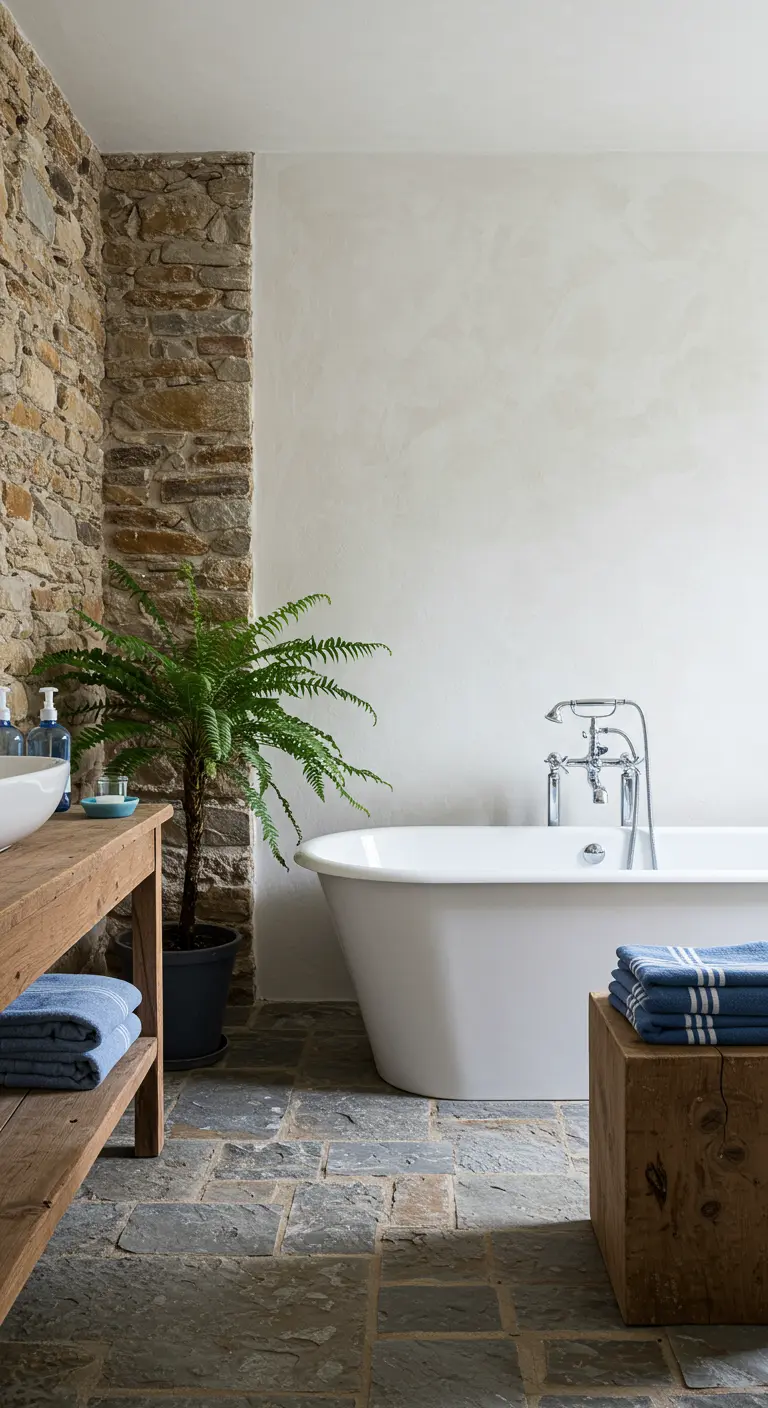
Elevate your bathroom design by creating a dynamic interplay of textures.
Juxtapose a rugged, exposed stone wall with the clean, smooth lines of a contemporary freestanding tub for a powerful visual statement.
Ground the space with natural materials, such as a rustic wood vanity and stone flooring, to maintain a connection to the earth.
The addition of a lush, green fern introduces life and softness, completing the feeling of a private spa-like bathroom retreat.
12. Soften Your Workspace with Curves and Nature
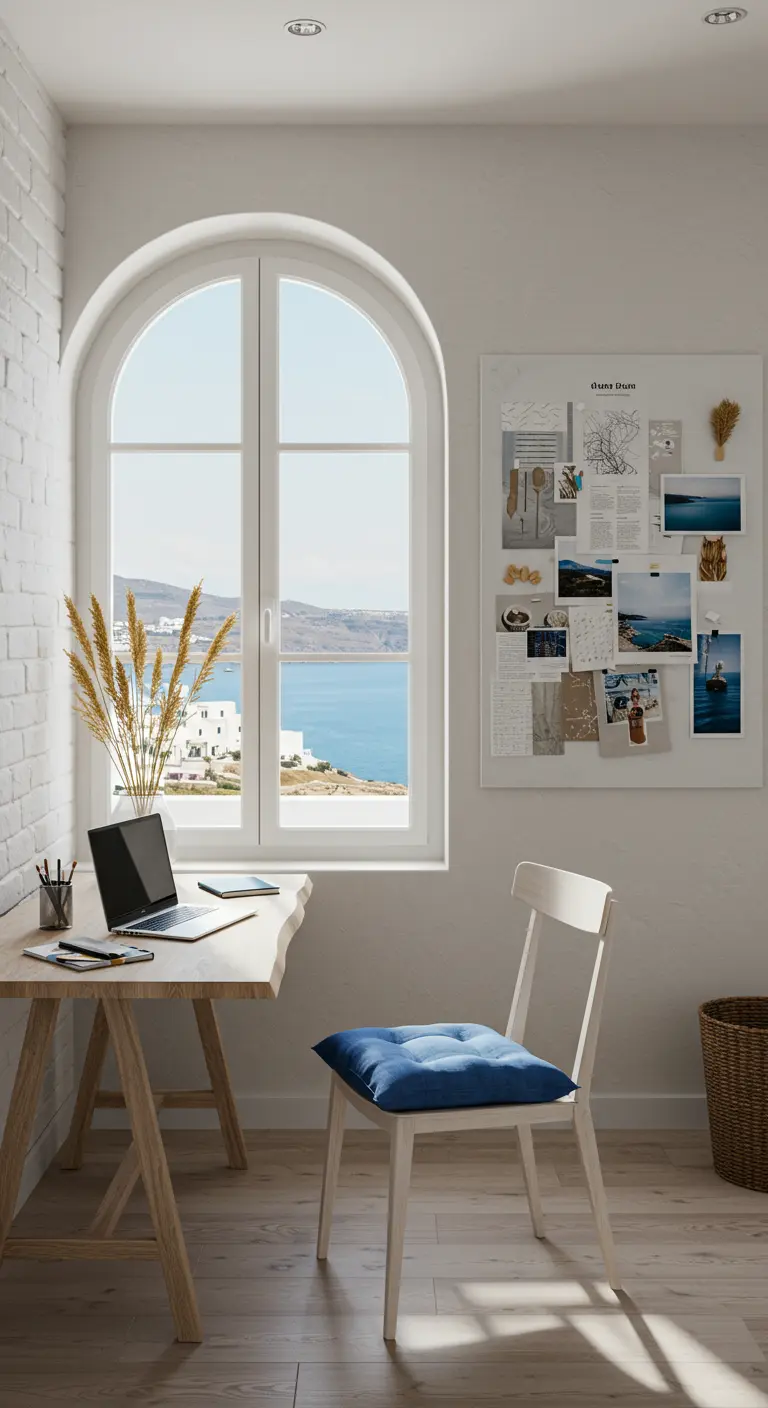
A home office can be both functional and serene.
An arched window softens the geometry of a room and frames the exterior view like a painting.
Echo this softness with a live-edge desk; its organic, imperfect shape offers a welcome break from the hard lines of technology.
A simple material palette and a single pop of color on the seat cushion keeps the focus on the nature-inspired view and materials.
13. Dissolve the Boundary Between Inside and Out
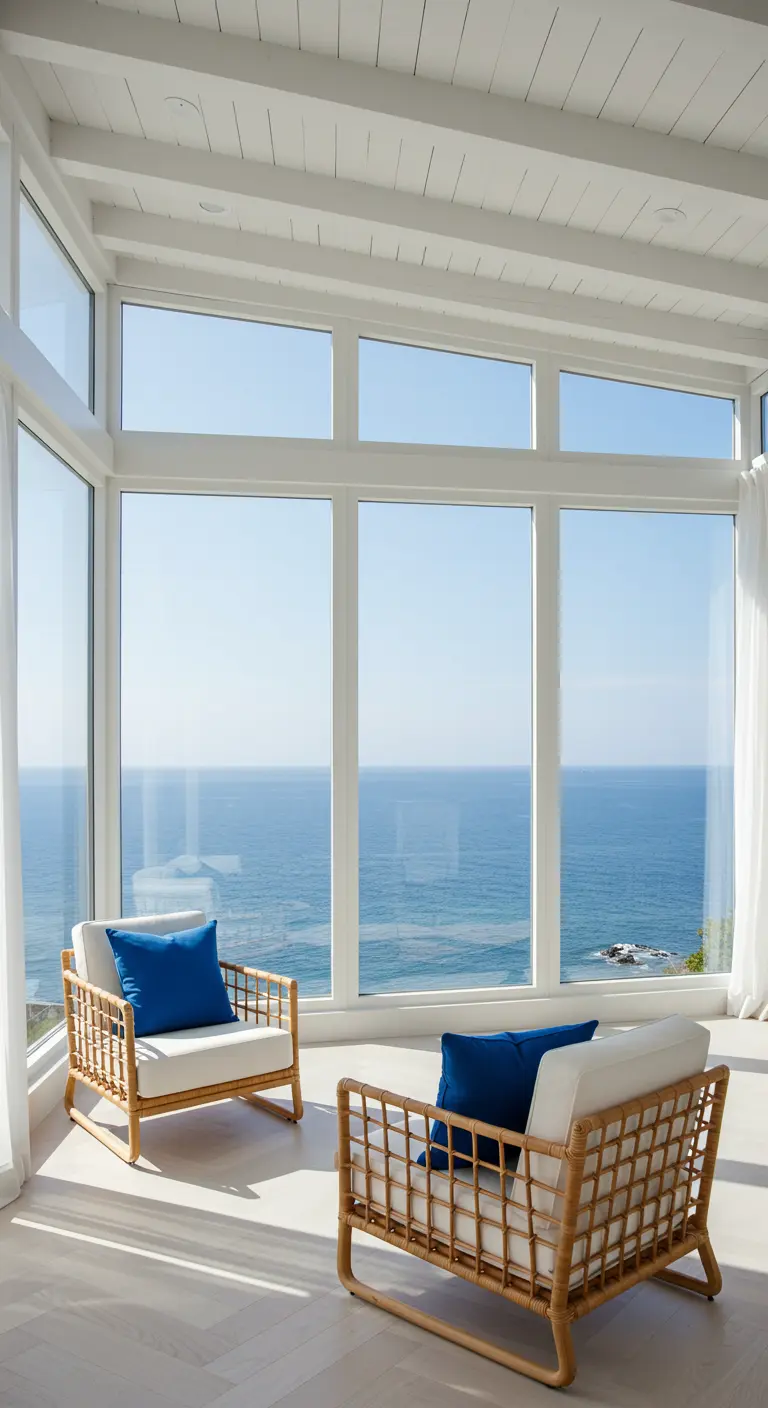
When your view is the main event, your design should support it, not compete with it.
Floor-to-ceiling windows effectively erase the walls, creating an immersive experience of the landscape.
Select furniture that is light in scale and material, like this rattan set, to keep sightlines open and unobstructed.
A minimalist white palette accented with wood and a touch of deep blue ensures the ocean remains the primary focus.
14. Use Symmetry to Create a Serene Guest Room
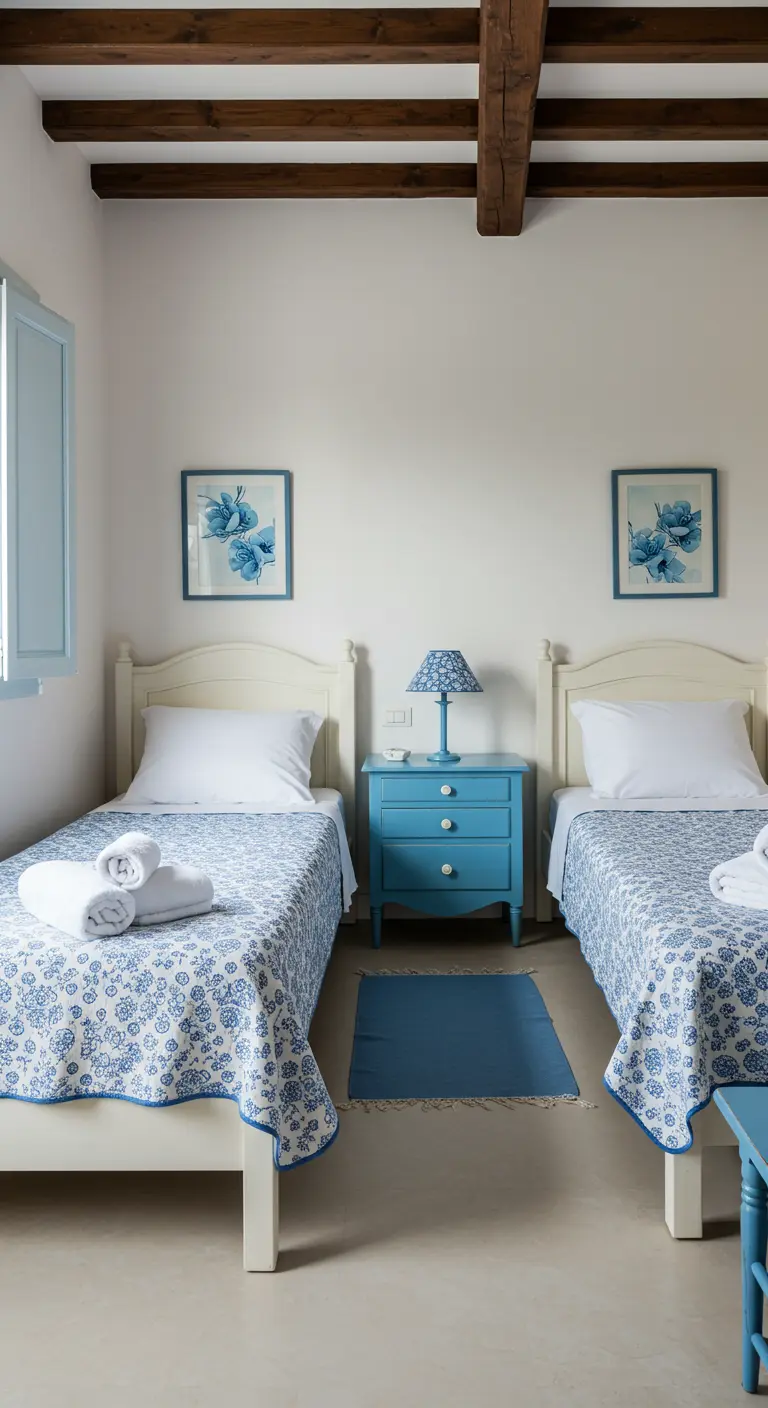
In a shared bedroom, symmetry is the most powerful tool for establishing a sense of calm and order.
Matching beds, identical quilts, and balanced artwork create a pleasing, mirror-image effect that is inherently restful.
Anchor the composition with a single nightstand between the beds, painted in a coordinating accent color.
This classic approach ensures the space feels balanced, welcoming, and intentionally designed.
15. Anchor Your Dining Room with Sculptural Lighting
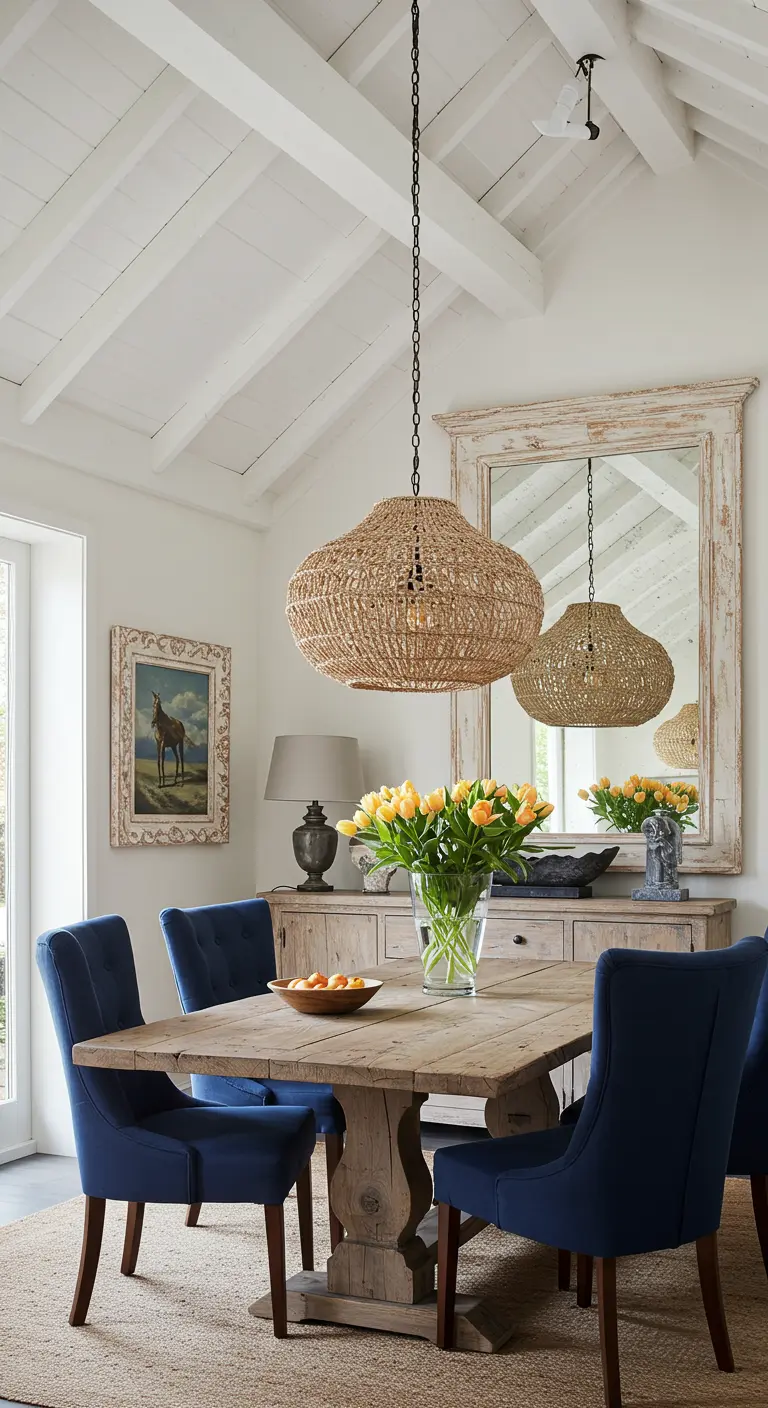
In a room with high or vaulted ceilings, oversized woven pendants do more than just provide light.
They act as large-scale sculptural pieces that visually lower the ceiling and create a more intimate dining area.
Their natural texture adds essential warmth that balances the cool white walls.
Pair them with dark, upholstered chairs to ground the space and add a note of refined comfort, perfect for a hygge dining room.
16. Turn a Staircase into a Graphic Statement
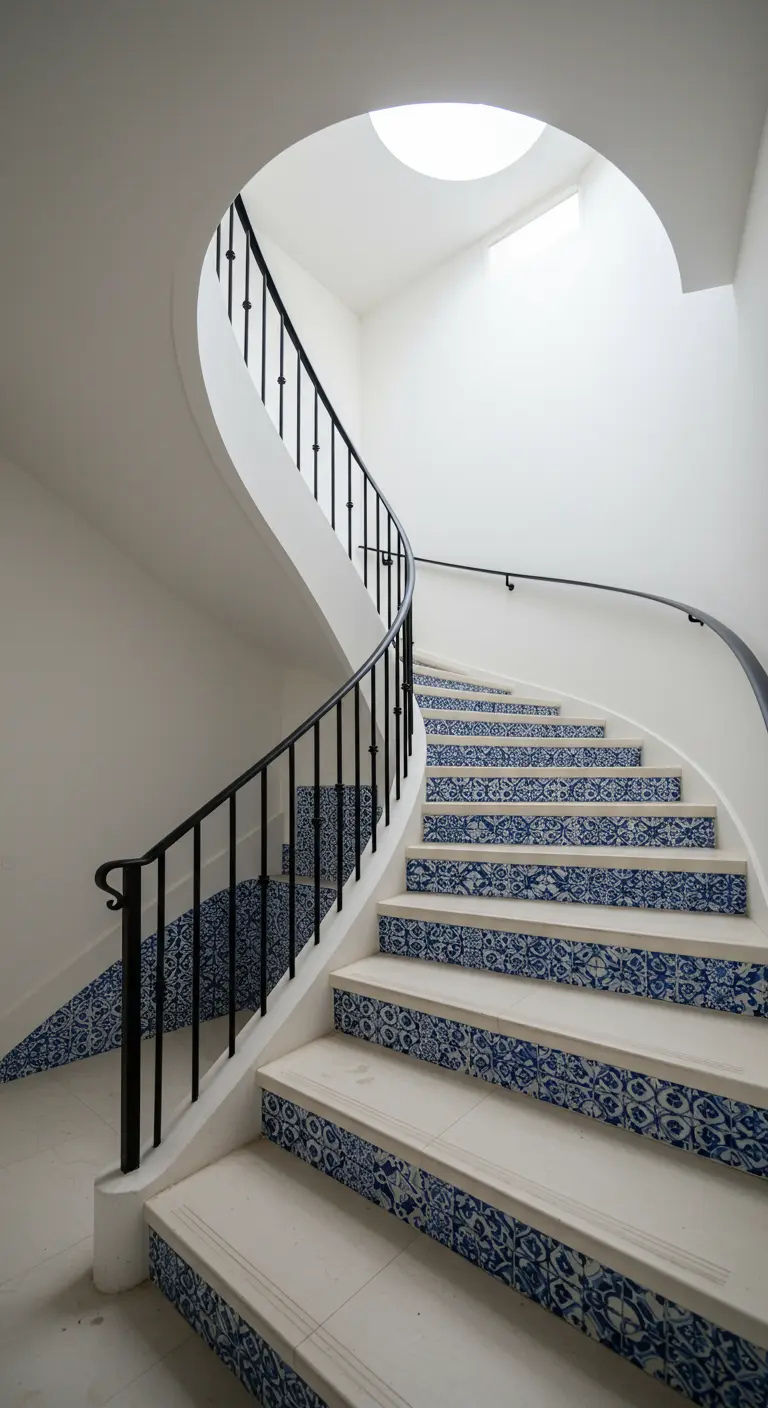
A staircase is a prime opportunity for a strong design moment.
Applying decorative tile to the risers adds a ribbon of pattern and color that guides the eye upward.
For this to have maximum impact, keep the stair treads and surrounding walls a clean, simple white.
A slim, black iron railing provides a bold graphic line that contrasts beautifully with the intricate tilework, similar to the effect of geometric floor tiles.
17. Gather Around a Sculptural Fireplace
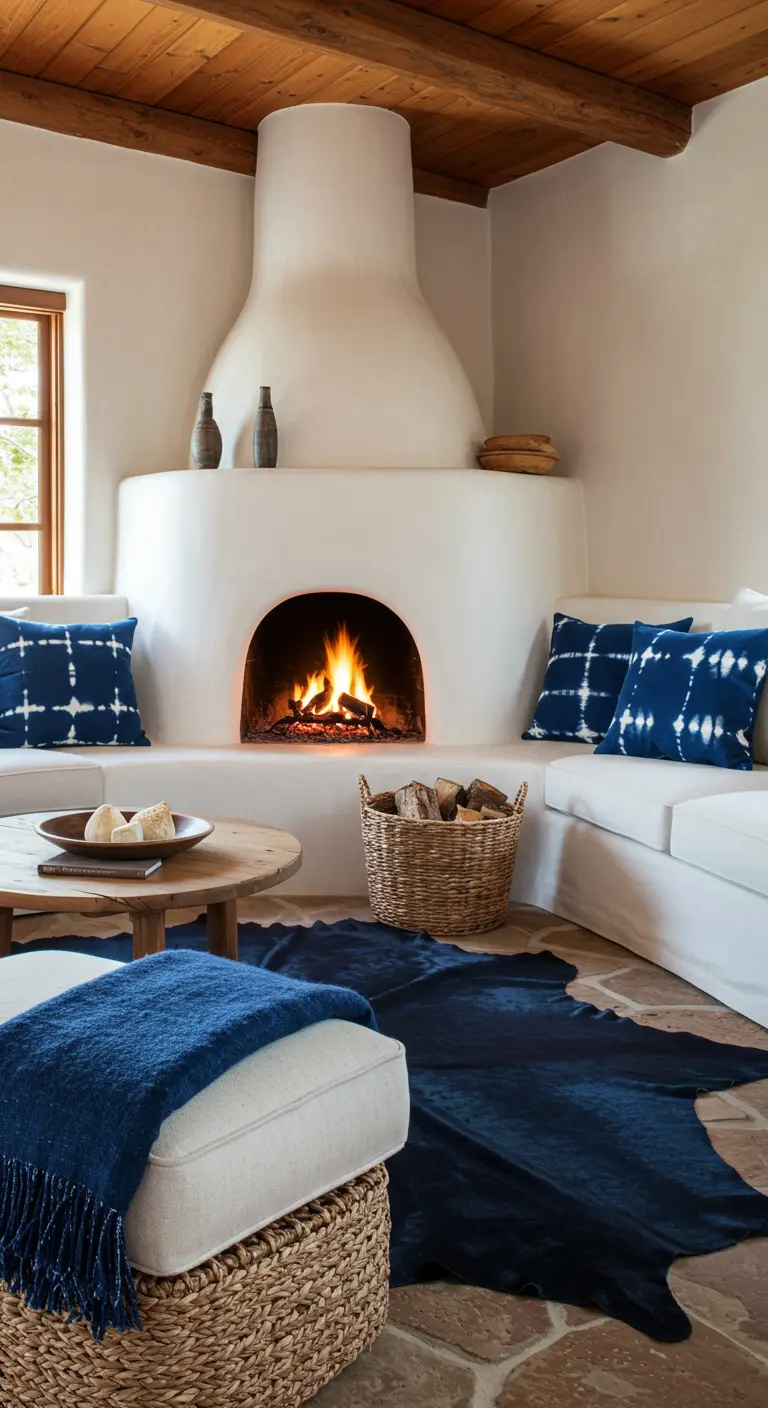
A kiva-style fireplace, with its soft curves and plaster finish, serves as the sculptural heart of a room.
Its form naturally encourages gathering, so arrange your seating to face it, creating an intuitive conversation area.
Contrast the fireplace’s warm, earthy presence with cool, deep indigo textiles—a faux hide rug, shibori-dyed pillows, and a cozy throw.
This combination of warm earth tones and rich blues is both grounding and dynamic.
18. Make the Kitchen Island Your Focal Point
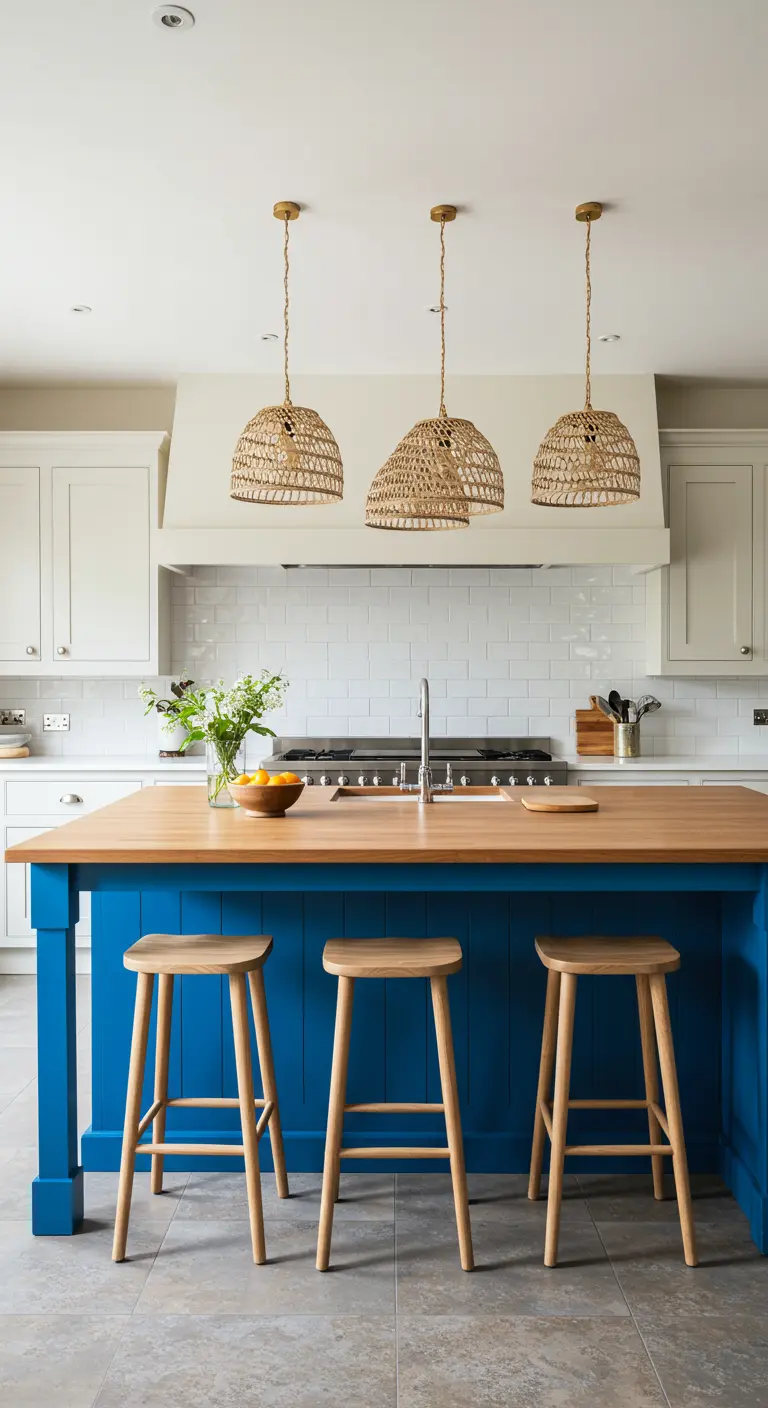
Transform a standard kitchen by painting the island in a bold, saturated color.
A vibrant blue makes the island the undeniable star of the room and gives the entire space a custom-designed feel.
To support this strong choice, keep the surrounding elements neutral: white shaker cabinets and a simple tile backsplash.
Warm materials like a butcher block countertop and woven pendants ensure the space feels balanced and inviting, much like these coastal modern kitchens.
19. Frame the View with Colorful Doors
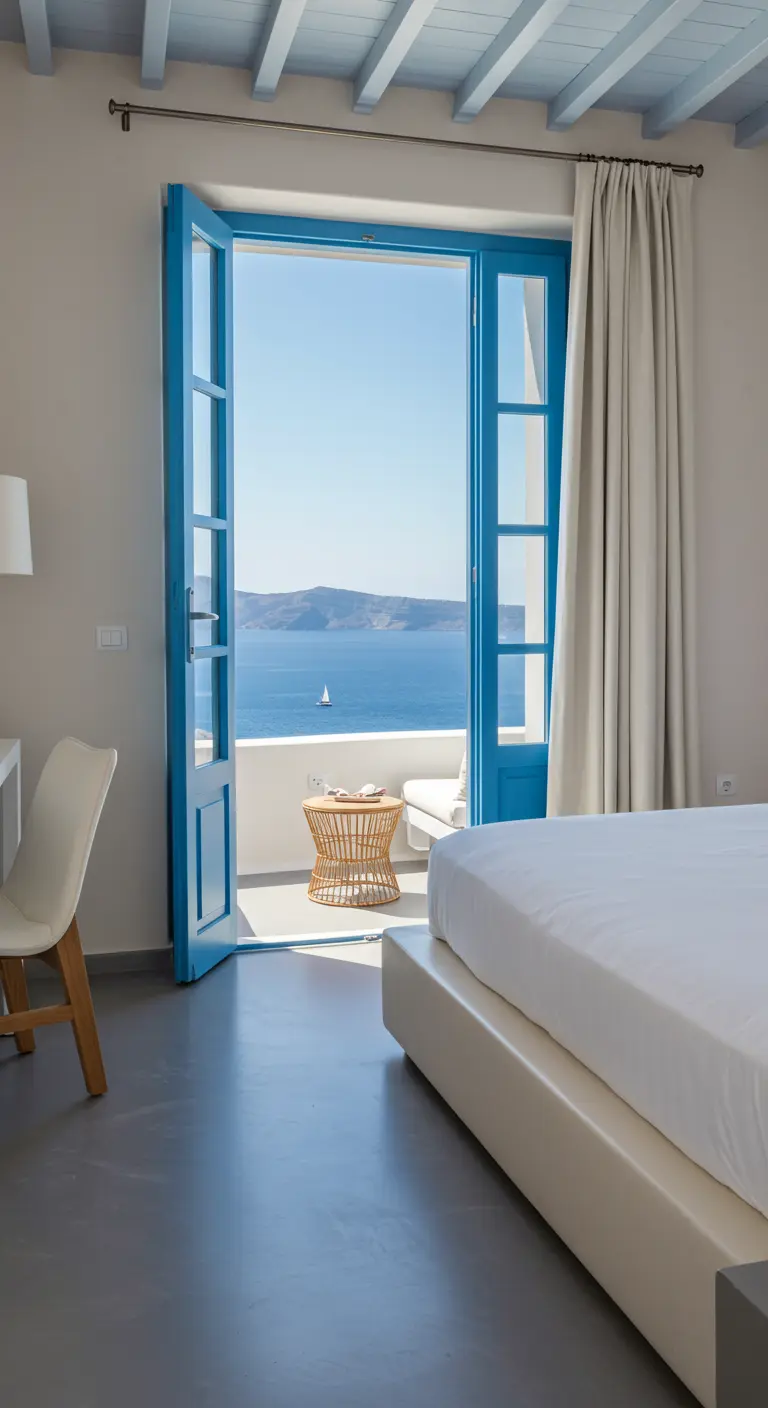
Instead of letting them blend in, treat the doors to your balcony as an active design element.
Painting them a striking shade of blue turns them into a picture frame, enhancing the view of the sea and sky.
This choice creates a strong visual connection between the interior and exterior spaces.
When closed, the doors provide a beautiful block of color; when open, they create a seamless transition to the outdoors.
20. Soften Architecture with Textiles and Greenery
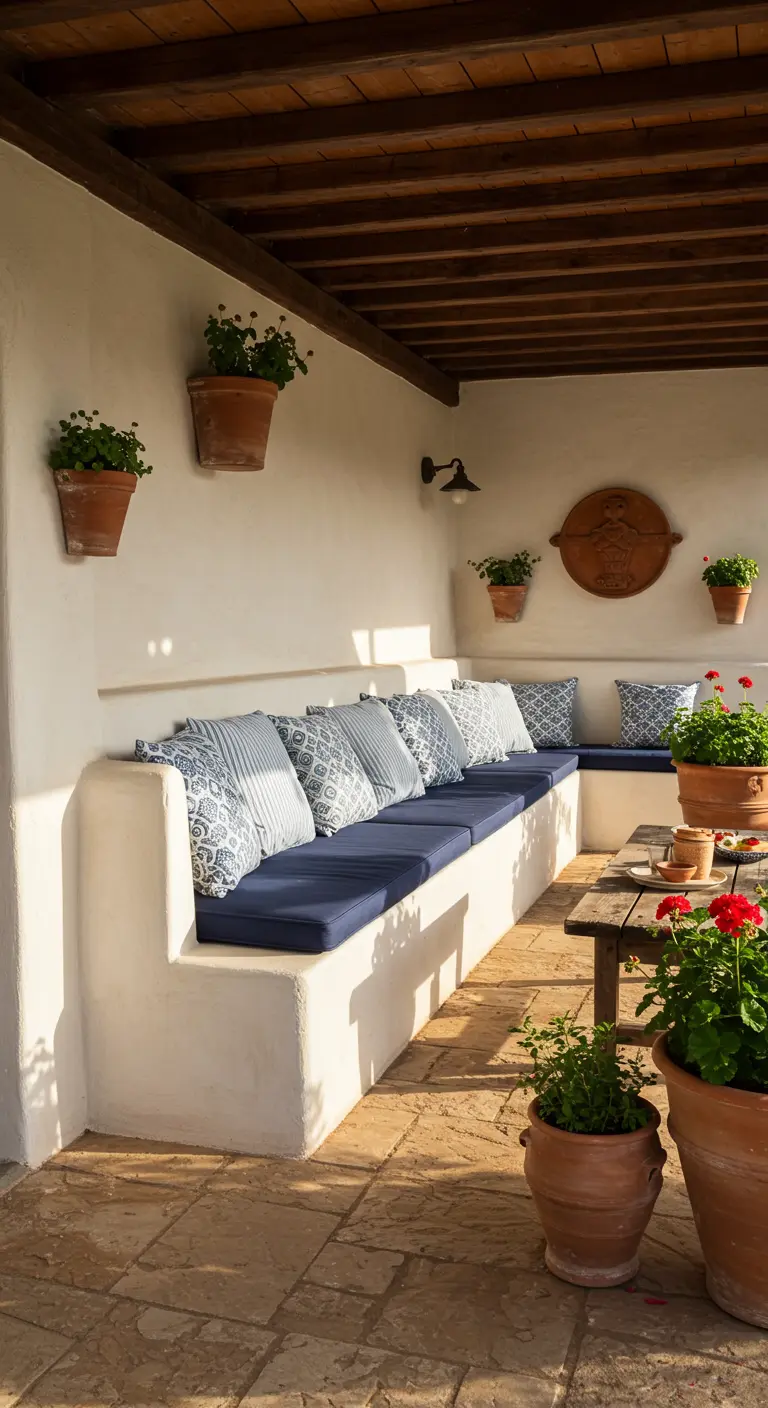
Built-in plaster or concrete benches are functional and authentic, but they require softening to feel truly comfortable.
Use deep, solid-colored cushions as a base, then layer on pillows with varied but complementary patterns to add visual interest.
This layering of textiles breaks up the hard lines of the architecture.
Incorporate simple terracotta pots with flowers or herbs to add life, color, and a touch of the bohemian garden vibe.
21. Unify Split Levels with an Accent Color
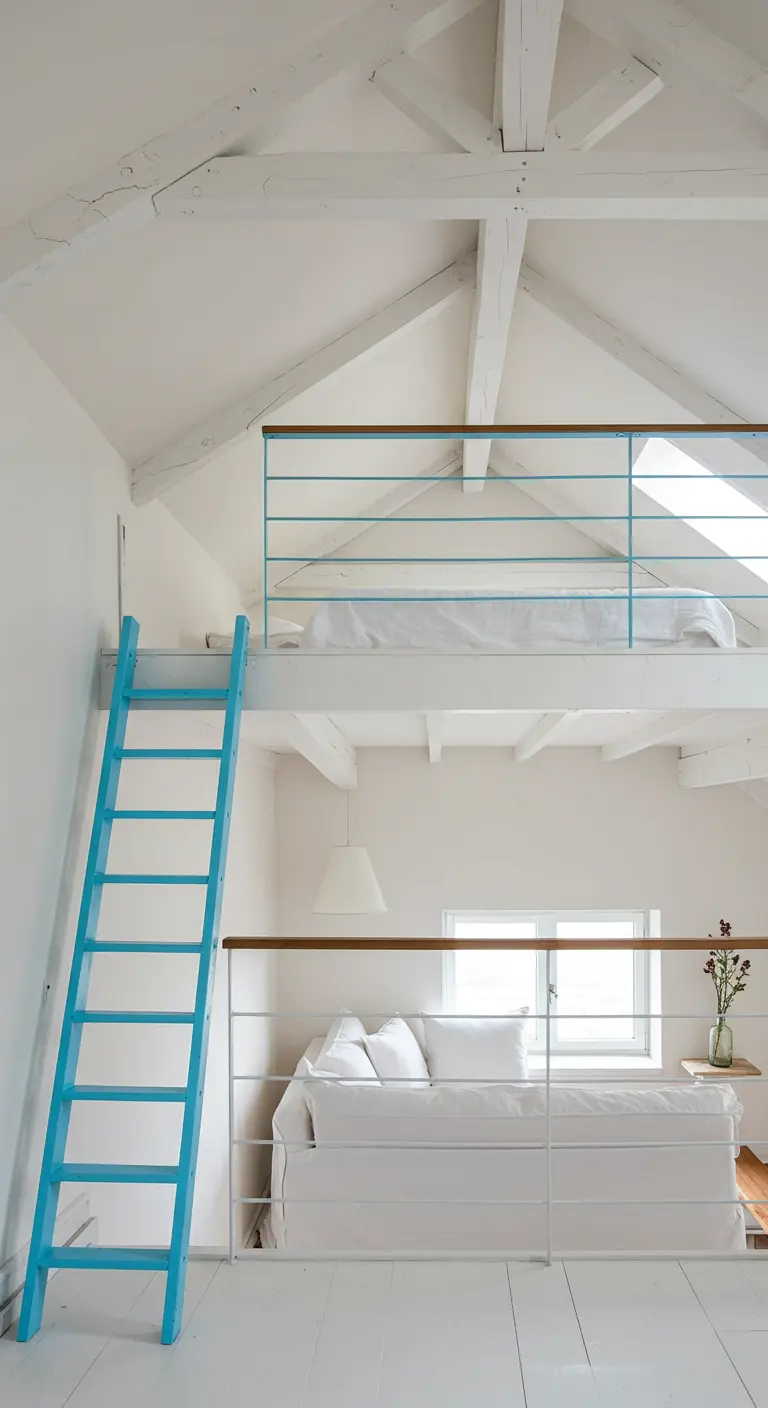
In a multi-level space, a single, consistently used accent color can create a powerful sense of cohesion.
By painting the access ladder and the loft railing in the same shade of light blue, you visually connect the upper and lower areas.
This purposeful choice transforms purely functional hardware into a graphic design feature.
The airy color ensures the metalwork feels light and integrated within the all-white, beamed space.
22. Elevate the Vanity with a Full Tile Wall

Instead of a standard 4-inch backsplash, make a bolder statement by tiling the entire wall behind your bathroom vanity.
This approach creates a luxurious feature that makes the room feel more spacious and thoughtfully designed.
Balance the intricate pattern with simple, natural materials like a floating wood countertop and rustic, weathered mirror frames.
This combination of colorful tiles and vintage fixtures feels both timeless and personal.
